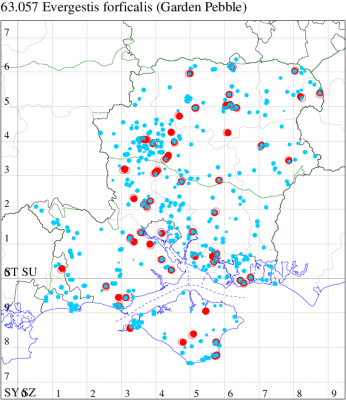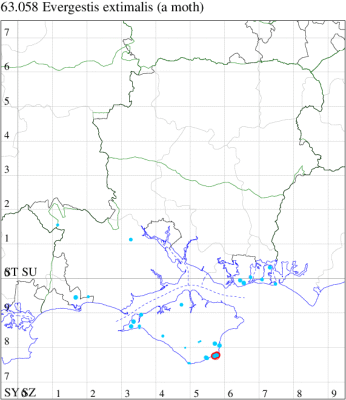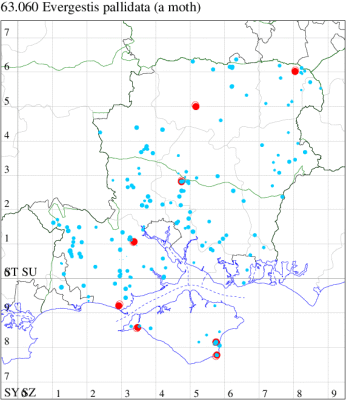2020 Annual Report for: Crambidae / Glaphyriinae
For species seen in 2020 that had less than or equal to 100 records, full details are included; for more common species, the earliest, latest and highest count by vice-county are shown. The narrative for each species is taken from the main Hantsmoths website, and it is possible that some information on abundance and occurrence can get out of date, as it is impossible to keep up with all changes; however it should give a good introduction to each species. The tables in each species account summarise the previous status, and that for the current year.
For the maps, all records prior to 2020 are shown by a blue dot (the larger the dot, the more recent), with the current year's records shown in red. As previous records are superimposed on any report for 2020, new sites have greater emphasis (i.e. will show as 'more red').
In the species accounts, an asterisk next to a location indicates a new 10km square record; earliest ever dates are highlighted in orange, and latest ever in red. Initials in the species accounts refer to the recorders listed here. Please get in touch if you identify any omissions or errors, in particular if you have records that have yet to be submitted. Details of how to submit records can be found here.
63.057 [B&F: 1356] Garden Pebble Evergestis forficalis (Linnaeus, 1758) - Common
Common in gardens, allotments and farmland, especially where Brassica are grown, throughout the British Isles. Widespread and fairly common in Hampshire and on the Isle of Wight. Wingspan 27-31 mm. Unlikely to be confused with any other species of British moth. Larva feeds on various Cruciferae, causing sufficient damage to be a serious pest in some areas.
Records prior to 2020
| Vice County | #Records | #Individuals | First Record | Last Record |
|---|---|---|---|---|
| 10 | 357 | 477 | 1977 | 2019 |
| 11 | 3496 | 4512 | 1951 | 2019 |
| 12 | 1048 | 1235 | 1951 | 2019 |
2020 records
| Vice County | #Records | #Individuals | Max Quantity |
|---|---|---|---|
| 10 | 31 | 41 | 3 |
| 11 | 83 | 90 | 4 |
| 12 | 33 | 35 | 2 |

Records by year
Records by week (adult)
Records by week (larval)
Record Summary
VC10: Earliest: Bonchurch, 12 May, 1 (JHa) Latest: Shanklin, 13 Aug, 2 (IOu) Max count: Bonchurch, 12 Jul, 3 (JHa)
VC11: Earliest: Southampton, 03 May, 2 (MEdg) Latest: Southsea, 13 Sep, 1 (JGe) Max count: Totton, 23 Aug, 4 (LH)
VC12: Earliest: Farnborough, 03 May, 1 (KBW) Latest: Anna Valley, Andover, 02 Sep, 1 (TJN) Max count: Cholderton, 08 Aug, 4 (TJN, HE)
63.058 [B&F: 1357] Evergestis extimalis (Scopoli, 1763) - Local
Local on chalk downland and calcareous soils in parts of East Anglia and the Thames Estuary, also appearing as a migrant on the south coast of England, in some years arriving in sufficient numbers to breed. In Hampshire and on the Isle of Wight an uncommon migrant, appearing mostly on southern coasts and infrequent inland, which may occasionally breed. Wingspan 27-31 mm. Distinctive and easy to recognise. Larvae feeds within seedheads of various Cruciferae.
Records prior to 2020
| Vice County | #Records | #Individuals | First Record | Last Record |
|---|---|---|---|---|
| 10 | 82 | 80 | 1858 | 2019 |
| 11 | 36 | 32 | 1951 | 2019 |
| 12 | 5 | 0 | 1945 | 1981 |
2020 records
| Vice County | #Records | #Individuals | Max Quantity |
|---|---|---|---|
| 10 | 2 | 2 | 1 |

Records by year
Records by week (adult)
Records by week (larval)
Record Details
VC10: Wheelers Bay, one, 09 Aug (ABu); Bonchurch, one, 25 Jun (JHa)
63.059 [B&F: 1356a] Evergestis limbata (Linnaeus, 1767) - Nationally Scarce B
A local species found on rough ground in southern England. Since its arrival on the Isle of Wight in 1994, numbers have increased throughout the early 21st century and it is now established as a breeding species across southern England. In Hampshire and on the Isle of Wight after the first British record at Chale Green on the Island on 23 July 1994, it is now regular in the southern half of Hampshire and the Isle of Wight, and is probably resident north to central Hampshire, particularly along the Test and Itchen valleys, and can be expected to turn up anywhere. Wingspan 20-23 mm. Distinctive and easy to recognise. Larva feeds on Garlic Mustard and Hedge Mustard.
Records prior to 2020
| Vice County | #Records | #Individuals | First Record | Last Record |
|---|---|---|---|---|
| 10 | 235 | 429 | 1994 | 2019 |
| 11 | 293 | 293 | 2000 | 2019 |
| 12 | 63 | 71 | 2005 | 2019 |
2020 records
| Vice County | #Records | #Individuals | Max Quantity |
|---|---|---|---|
| 10 | 20 | 36 | 5 |
| 11 | 53 | 54 | 3 |
| 12 | 18 | 19 | 2 |

Records by year
Records by week (adult)
Records by week (larval)
Record Summary
VC10: Earliest: Bonchurch, 02 Jun, 1 (JHa) Latest: West High Down Quarry, 08 Sep, 1 (IOu) Max count: Bonchurch, 24 Jun, 5 (JHa)
VC11: Earliest: Northney, Hayling Island, 07 Jun, 0 (JWP) Latest: Milford on Sea, 14 Sep, 1 (MMcM) Max count: Fareham, 25 Jun, 3 (KJW)
VC12: Earliest: Crawley, 02 Jun, 1 (TNo) Latest: Hinton Ampner, 19 Sep, 1 (ASD) Max count: Crawley, 21 Jul, 2 (GCE)
63.060 [B&F: 1358] Evergestis pallidata (Hufnagel, 1767) - Common
Common in damp woodland throughout southern England, and less commonly in south-western Scotland and Ireland. Widely distributed and fairly common in Hampshire and on the Isle of Wight. Wingspan 24-29 mm. The reticulate effect of dark cross-lines and veins make this an easy species to recognise [Goater]. Larva feeds on Winter-cress.
Records prior to 2020
| Vice County | #Records | #Individuals | First Record | Last Record |
|---|---|---|---|---|
| 10 | 31 | 20 | 1856 | 2019 |
| 11 | 307 | 250 | 1951 | 2019 |
| 12 | 111 | 94 | 1951 | 2019 |
2020 records
| Vice County | #Records | #Individuals | Max Quantity |
|---|---|---|---|
| 10 | 4 | 4 | 1 |
| 11 | 3 | 3 | 1 |
| 12 | 1 | 1 | 1 |

Records by year
Records by week (adult)
Records by week (larval)
Record Details
VC10: Freshwater Cliffs, one, 09 Aug (SDa); Bonchurch, one, 05 Aug (JHa); Shanklin, one, 26 Jul; one, 30 Jul (IOu);
VC11: Ashurst, NF, one, 06 Aug (SAB); Winchester, one, 17 Jul (THW); Wickham, one, 02 Aug; two, 05 Aug; one, 06 Aug (JRDS); Petersfield, one, to actinic, 07 Aug (RAll); Milford on Sea, one, 09 Aug (MMcM);
VC12: Overton Lagoons, one, field observation, 23 Jun (PEH); Yateley, one, 08 Aug (JHH)